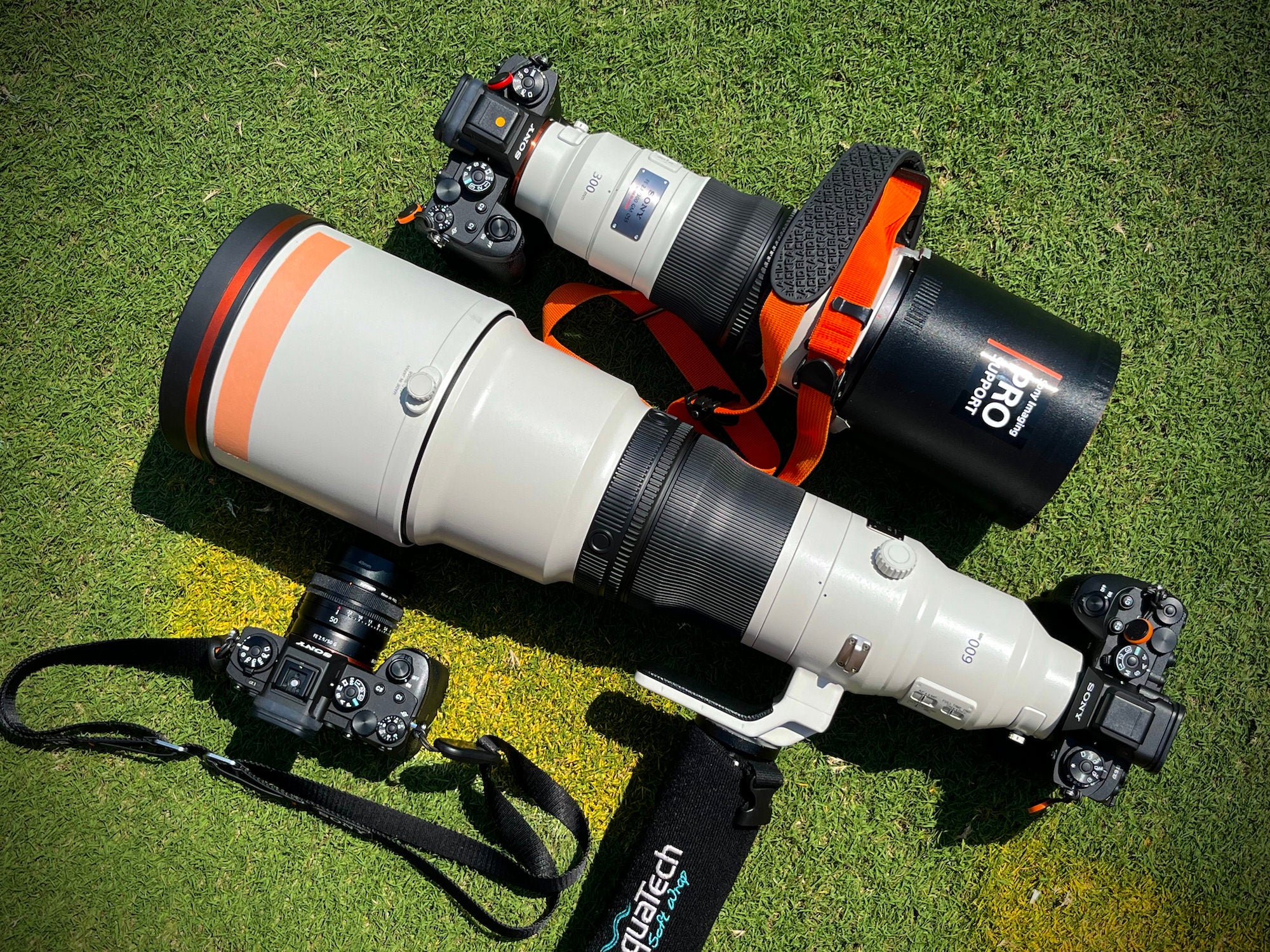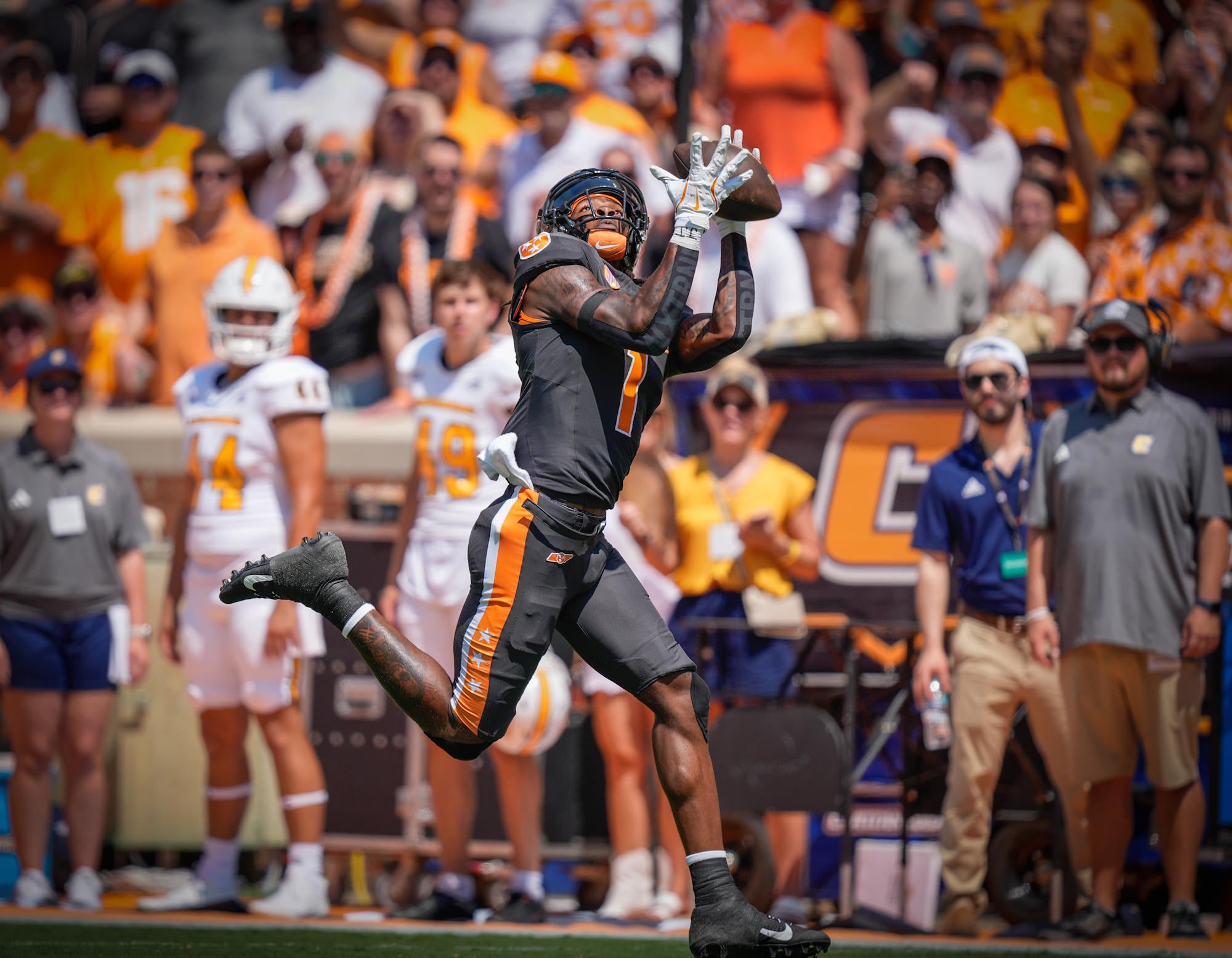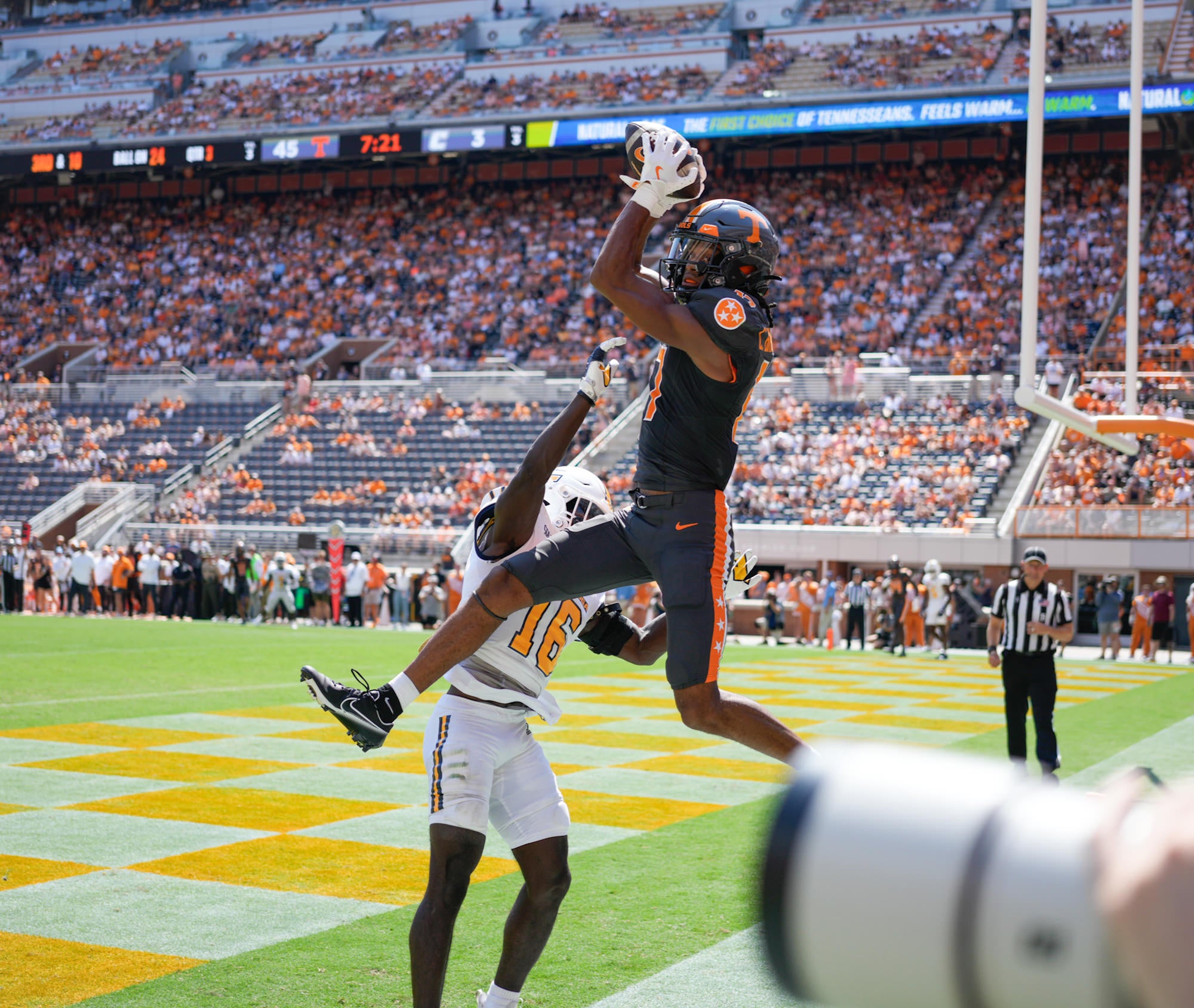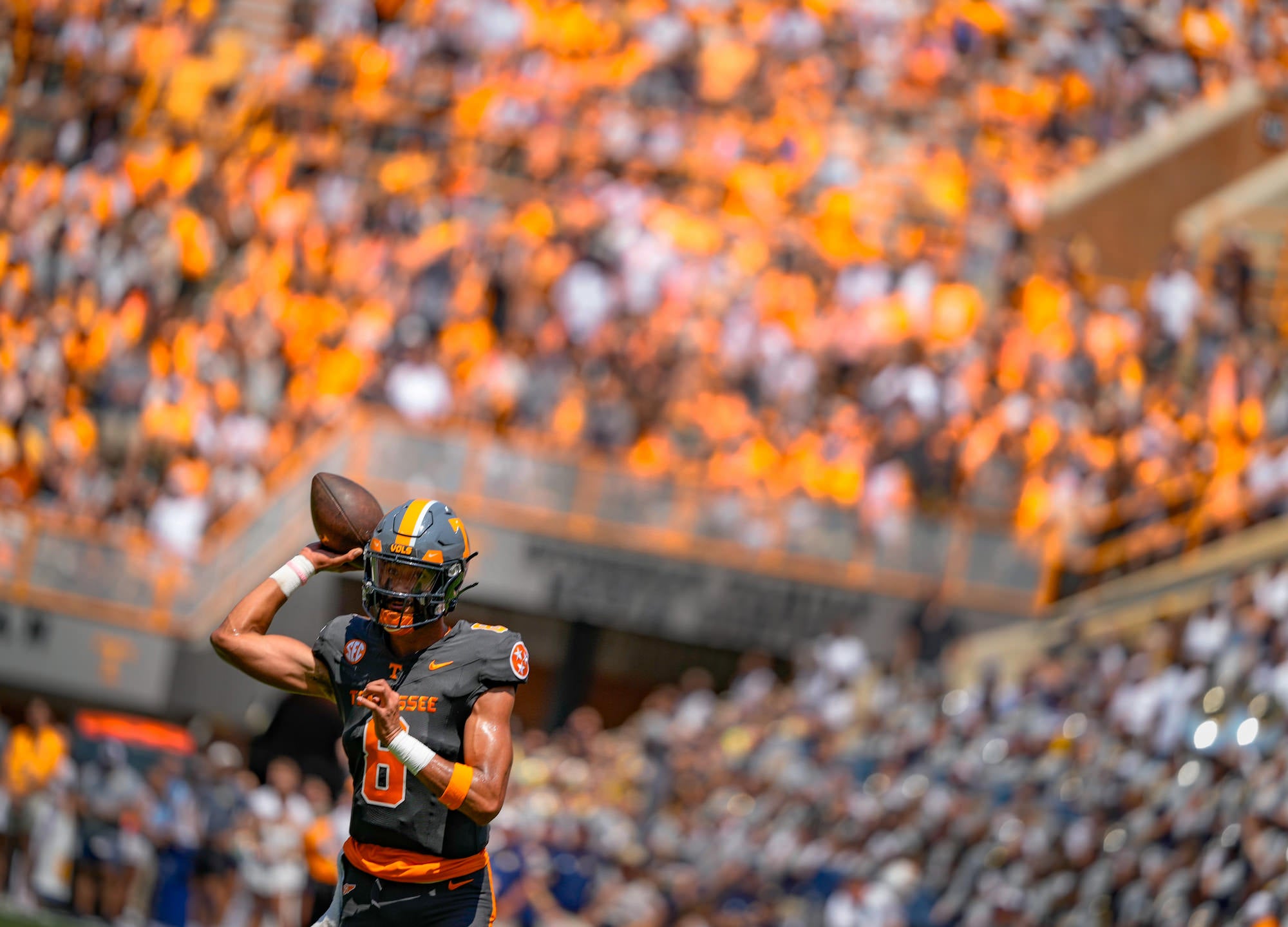Veteran sports photojournalist and Sony Artisan Patrick Murphy-Racey has more than 25 years of experience capturing sports action at the highest levels. He has honed his gear combinations for different sports, and for both college and professional football he’s developed the perfect triple combo setup that covers everything he needs. Keep reading as he shares what’s in his bag for college and professional football, and stay tuned to Alpha Universe as he’ll be sharing his kit for other sports later in the year.
Product Preview – In This Article You’ll Find:
–Sony Alpha 1
–Sony Alpha 9 III
–Sony 50mm f/2.5 G
–Sony 300mm f/2.8 G Master
–Sony 600mm f/4 G Master
–Sony 1.4X Teleconverter
–Sony 2.0X Teleconverter

Cameras
Sony Alpha 1: The camera choice is really easy for me for football. I use a Sony Alpha 1 around my neck with the Sony 50mm f/2.5 G compact prime on it and without a battery grip. The only other change I make is that I enable “AF with shutter,” in this one specific use, so that when I grab and shoot with it, it is AF-ing as I am pressing the shutter button at 30 fps. In this way my 50mm setup is better than John Beiver’s gaff tape because the AF is so fast with Sony it can keep up with focus with ease, even when players are literally flying in the air towards you.
Photo by Patrick Murphy-Racey. Sony Alpha 1. Sony 300mm f/2.8 G Master. 1/4000-sec., f/2.8, ISO 400
Sony Alpha 9 III (2): I use my first Sony Alpha 9 III on the Sony 600mm f/4 G Master because it is the lens that produces the most for me as I can shoot the entire field even when they are on the opposite end of the pitch. This combination allows me to shoot 30 fps normally and up to 60 fps if I hit the magic button. I’ve not found a use for 120 fps so far for football. It's just too fast. I have my largest CF-A card in that camera too, because of the extreme frame rates possible. I use a German-made Feisol monopod that I really like. It’s made of carbon fiber and is really strong but weighs nothing.
Photo by Patrick Murphy-Racey. Sony Alpha 9 III. Sony 600mm f/4 G Master. 1/3200-sec., f/4, ISO 320
I use my second Sony Alpha 9 III body with battery grip on the Sony 300mm f/2.8 G Master and hang that off my left shoulder on my right side with a Black Rapid Strap which is shown in the photo. Being able to not have to use a monopod is a massive advantage when using the Sony 300mm f/2.8 G Master. I carry it that way for about five hours on game days and my shoulders are never tired. The speed of the AF on the new Sony 300mm f/2.8 G Master is crazy fast but also accurate too. The combination of the Sony 300mm f/2.8 G Master with any Sony Alpha sports body is amazing.
Lenses
With these three lenses, I am always confident that if I fail to make a picture of an important play on the field, it’s most likely me that failed and not the glass or the cameras.
Sony 50mm f/2.5 G: First, the “Nifty 50.” The 50mm focal length was pretty much dead when I came into photography hard and fast back in the mid-1980’s. Every camera pretty much came with one so no one was very interested in shooting with that lens. Good, sharp zooms were a few years away. But there was an exception with the first of the many Sports Illustrated shooters that I got to know throughout my career. John Biever was, and is still THE football photographer GOAT and each time I got to shoot the Packers, I’d pay close attention to what lenses he was shooting. The one consistent thing I saw him do at every game was have a 50mm lens around his neck at all times. I spoke to him about this and he explained that he would pre-focus at 20 feet and then he’d gaff tape the focus ring so it couldn’t move. I began to do the same and it paid off big dividends at many games. He called it the, “Oh crap camera.”
There you’d be, shooting the line of scrimmage 50 yards away and then a long pass would start your way. You had to stop and drop whatever you were shooting with and then transition to the 50mm in time before the play ended up in your lap. I have been doing this since I could afford three bodies. The square touchdown photo was shot last weekend with this exact setup. Sony makes a total of four 50mm lenses (and one 55mm) so you might wonder why I don’t use any of the others. The compact prime lenses all have dual linear AF motors and are among the fastest focusing lenses Sony makes right now. They have tiny optics that move fast and they are dead sharp wide open. The Sony 50mm f/2.5 G is perfect as it is the lightest weight of all of them and is really tiny so it packs easily into a case with other gear. I shoot the Sony 50mm f/2.5 G with the Sony Alpha 1 body without a grip to keep the combo lightweight, and if I need to crop a little, I’ve got nothing but real estate on that big sensor.
Photo by Patrick Murphy-Racey. Sony Alpha 1. Sony 50mm f/2.5 G. 1/3200-sec., f/2.5, ISO 200
Sony 300mm f/2.8 G Master: Second is the new Sony 300mm f/2.8 G Master lens which I adore. Once Sony started shipping these, I actually sold my Sony 400mm f/2.8 G Master immediately in anticipation of getting the Sony 300mm f/2.8 G Master. So far, I’ve had no regrets but mostly due to the fact that I have a Sony 600mm f/4 G Master as well. If you can only justify one long fast lens, the Sony 400mm f/2.8 G Master is still the one to get. While I use the Sony 600mm f/4 G Master lens the most and shoot 85% of all the photos at games with it, once the offense get into range inside the 20-25 yard line, I switch to the SSony 300mm f/2.8 G Master. Here I can shoot at a slightly lower ISO but still keep my shutter speeds high.
The Sony 300mm f/2.8 G Master has beautiful bokeh and makes the crazy busy backgrounds at D1 college games into beautiful watercolors. At exactly half the focal length of the Sony 600mm f/4 G Master, the Sony 300mm f/2.8 G Master allows me to see more as the action unfolds so I don’t miss touchdown plays or the fanatical special teams’ performance. The Sony 300mm f/2.8 G Master is king of the Red Zone! I use the Zemlin extended lens shade on my Sony 300mm f/2.8 G Master because I love to shoot back-lit and sometimes with a Sony 1.4X Teleconverter or Sony 2.0X Teleconverter. The stock Sony shade is perfect for basketball and volleyball, however.
Photo by Patrick Murphy-Racey. Sony Alpha 1. Sony 300mm f/2.8 G Master. 1/4000-sec., f/2.8, ISO 250
Sony 600mm f/4 G Master: The Sony 600mm f/4 G Master and I have a relationship. We go back over 30 years together. “The 6,” as it’s often called by sports shooters, is simply an eye candy machine. If you can find the action, it will perform and produce images that are beyond stunning. Once Sony put the Sony 600mm f/4 G Master in my hands, this often low percentage lens immediately paid off. It is so sharp, fast and lightweight for what it is, it gives me a huge advantage.
The IBIS combined with OSS allows me to pan fast and nail images with a quickness never possible before. The Sony 600mm f/4 G Master also allows me to shoot players far away from me on the opposite end of the field and STILL blow the backgrounds out from behind those players. I often use the Sony 1.4X Teleconverter on the Sony 600mm f/4 G Master lens but not until fall weather cools down to avoid the troubling heat waves that plague us in the heat.
Photo by Patrick Murphy-Racey. Sony Alpha 9 III. Sony 600mm f/4 G Master. 1/4000-sec., f/4, ISO 800
Accessories
Black Rapid Strap: This is what I use for my second Sony Alpha 1 body with battery grip on the Sony 300mm f/2.8 G Master.
Battery Grips: I use these on my two Sony Alpha 1 cameras.
Feisol Monopod: I use a German-made Feisol monopod that I really like. It’s made of carbon fiber and is really strong but weighs nothing.
Zemlin Extended Lens Shade: I use the Zemlin extended lens shade on my Sony 300mm f/2.8 G Master because I love to shoot back-lit and sometimes with a Sony 1.4X Teleconverter or Sony 2.0X Teleconverter.
See more of Patrick Murphy-Racey’s work on his Alpha Universe Profile and at pmrphoto.com.


























